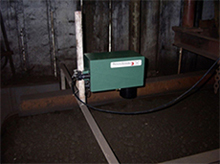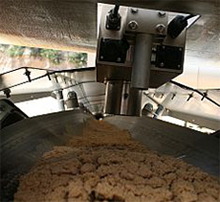Minerals
- Bauxite
- Chalk
- Coals
- Sand
- Foundry Sand
- Fiber Glass
- Cement
- Clays & Ceramics
- Crushed Limestone
- Sinter Mix
- Glass Cullet
- Bentonite
- Boric Acid
- Copper Tailings
- Ferrite Powder
- Dolomite (talc)
- Fly Ash
- Gypsum
- Iron Ore
- Peat Moss
- Perlite
- Slag (Furnace)
- Soda Ash
- Salt
- Titanium Dioxide
- Suplhur
- Zeolite
- Zinc Oxide
Why Measure?
ROI is rapid with Users quickly benefiting from a more efficient drying operation resulting in fuel savings and increased productivity.
Sensor
Either a cast aluminium MCT 360, ATEX 22-MCT 360 or MCT 330HD. The MCT 330HD helps avoid the necessity for a vortex cooler and air supply in situations where the ambient temperature is higher than 50°C, but lower than 65°C, it is also more practical in locations where the gauge may be hosed down. The Atex 22-MCT 360 gauge is required for installations where the dust environment is potentially hazardous.
Accessories
The MCT 360 is built to withstand conditions both inside and outside a plant, and has options that may be fitted should temperature conditions become extreme; a heat blanket can be fitted inside the gauge to ensure the internal temperature of the gauge doesn`t drop below x°C, and the addition of a vortex cooler and cooling panel will keep the gauge performing under ambient conditions of up to 80°C. The enclosure is IP65 rated, and as such, is dust and splashproof, but if the gauge is to be mounted outside it will benefit from a cover to protect it from driving rain, snow or direct sunlight. Product loss sensors are available to hold the signal unless product is fully under view.
Gauge outputs, Operator Interface & Display
The MCT 360 is available with or without a local operator interface or display as all the processing is carried out within the sensor head and the measurement is output via 4-20mA, 0-10V, RS232, RS485 or any bus. Installation time and effort is minimised by dispensing with a local OI, but should samples be collected for cross checks an OI is useful... in this event, one could be simply plugged into the gauge at the sampling location.
The Measurement
Gauges are delivered pre-calibrated using samples held at our manufacturing facility, or using customer samples. The accuracy is application dependent, ranging from +/- 0.1% to +/- 0.5% . Typically the darker the material appears, the more NIR absorbing it is, and the lower the signal level this means that materials such as crushed coal and coke will require a longer response time.















